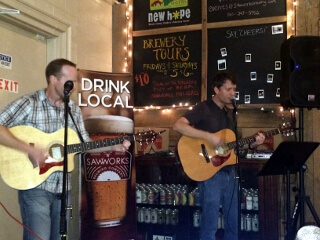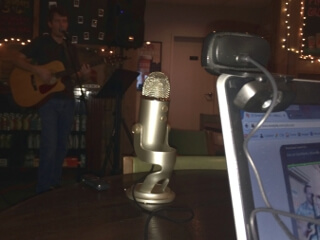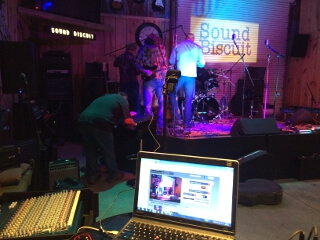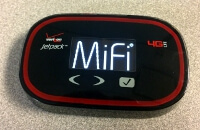How to deliver a hit performance on an online stage. This is your StreetJelly Guide to getting started and enjoying the creation of memorable e-concerts.
 Special guest blog by StreetJelly’s co-founder, Martina.
Special guest blog by StreetJelly’s co-founder, Martina.
“Here are helpful tips for live streaming musical performances based on feedback and suggestions from StreetJelly musicians, viewers, and staff.”
Music is a beautiful addition to the lives of millions of people around the world. Modern technology allows us to reach audiences we were never able to reach several years ago. An online streaming music service is a venue much like any conventional venue which unites musical performers and viewers in one place. Just like traditional performances, an online show should be considered that, a real show. Let me explain in detail why viewers prefer certain performances over others.
Positive headline
It all starts with a positive headline. A positive headline will attract viewers to your show. It does not have to be super witty and the catch-all phrase of the century. Keep it simple with uplifting words, and let it explain the type of performance and music genre. Negative headlines, like “I’m bored,” are not appealing! They will instantly result in turning viewers away from your performance.
Inviting and clean performance space
Regardless where your webcam is pointing, your are setting a stage for your show. Depending on your performance style, it can be anything from a casual corner in your home to a professionally decorated stage in a concert hall. Individual musicians and fans enjoy different types of shows. No matter the style of your stage, make it appealing to the viewers. Remove trash, clutter, dirty laundry, or anything from the camera that is a distraction. Double-check your image in the broadcast window. Your performance is greatly enhanced by a pleasant, neat surrounding. Many viewers truly appreciate the effort put into a well crafted stage. It will be the center of their attention and often result in increased tips or loyal followers.
Fill out your profile
Once you caught the viewers’ attention, your audience will be interested in finding out more about you. Make it easy for them to get that information by filling out your StreetJelly profile. Don’t forget to add links to your website, Facebook fan page, YouTube videos, and so on. Viewers will look you up at their convenience. Add your full name to your Bio, as well. This will help in Search Engine Optimization (SEO) and let viewers find you from Google and Bing.
No dead space during the performance
Prepare a show. Viewers appreciate the fact that some musicians can fulfill random requests. But generally, viewers enjoy a well prepared performance more. If you unexpectedly walk away from your show for extended periods of time and all your audience sees is an empty chair, it will result in losing viewers. Do not pause for more than a few minutes. If you have to take a longer break, end your show and tell the viewers you will return at a later time.
Put on a show, not a practice session
StreetJelly is a music performance site. Although we welcome performers with various skill levels, please do not use StreetJelly as a practicing platform. If your practice session is essentially identical to a performance and you consider it suitable for broadcasting, don’t label it as “only practicing.” (See “Positive headline” above.) This directs viewers to other performers who put on a well planned show.

“Flies” are Ok
StreetJelly gives viewers the option to chat during a performance, or to watch silently without logging in by name. We welcome both kinds of listeners. We call the viewers who don’t interact “Flies,” like a fly listening on the wall. Many regular viewers alternate between those two modes depending on where they are watching from, or their momentary listening preference. Some viewers prefer to remain anonymous all the time, some occasionally. We offer a guest tipping option for them, too, in case they wish to tip a musician and stay anonymous.
No official time limit on shows
Generally, a performance from 1 to 1½ hours appears to be very popular with viewers. We have several performers who put on longer shows with great success. It is up to each performer to choose how long and when they want to play. Any musician can pick a time and length of show convenient for him or her. StreetJelly has a wonderful community of supportive and respectful members. But every now and then, an individual musician will try to force his or her personal view (and time-slot) unto others about performance times, show durations, and so on. If you have any questions about this, please contact us at support@streetjelly.com.
No recordings
We do not allow playing full recorded music as karaoke or background accompaniment. This is a licensing issue and we ask you to follow this rule. In case we detect a violation of this policy, we reserve the right to shut down any performance. We do allow “backtracks.” Consider a backtrack recording as adding an extra instrument or two to your performance. Many musicians create their own original backtracks ahead of time.
Fill out your playlist
StreetJelly pays the licensing cover fees to various songwriter associations (BMI, ASCAP, etc.). Please fill out your playlist to ensure an accurate distribution of royalties. Maintaining your playlist repertoire will help you plan out your next show, too.
Don’t steal viewers from another performer’s show
Many musicians work hard to build their audience. Please do not go into an ongoing show and ask viewers to watch you instead. Committing this social faux-pas will instantly raise the eye-brows of both viewers and fellow musicians. They will boycott your show, guaranteed!
PG 13
Please keep your language suitable to a “PG 13” movie. We try to provide a pleasant environment for ALL our viewers and ensure an enjoyable experience for the majority of StreetJelly members. Read more about this topic: What is a Family Friendly Site?
Music can improve our daily lives on so many levels. It unites people, helps many of us through difficult times, or simply entertains us. We would like to thank everyone who visits this online venue and shares our passion for music and music lovers.
Martina
StreetJelly co-founder






